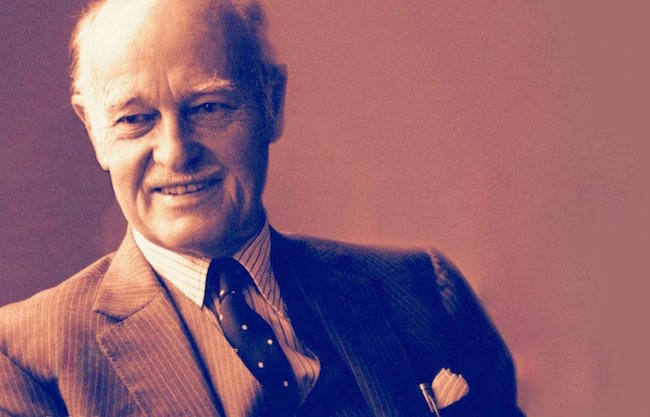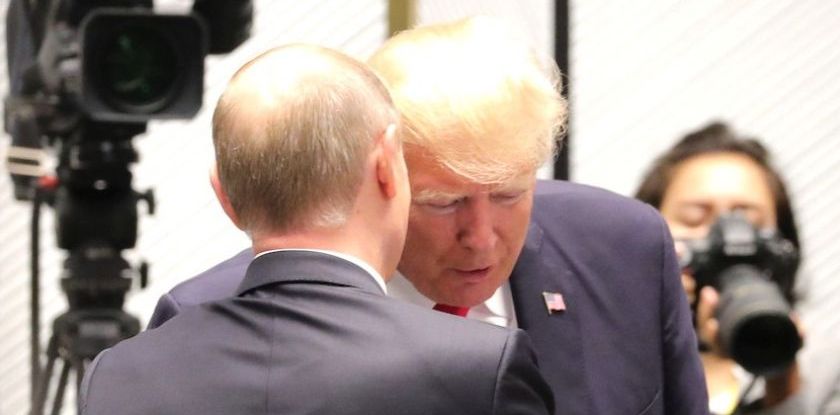 Alexei Tikhonov - 03.04.2018
Alexei Tikhonov - 03.04.2018
On the Modern Cold War Strategy
What has George Kennan taught us and what it means for Kazakhstan
The current international political situation is habitually called the Cold War. At the same time, however, they talk about one principle difference with the Cold War of the 20th century, namely, the absence of the fundamental ideological confrontation. Nonetheless, the person who once formulated the principles of the confrontation with the USSR believed the ideology be the consequence and not the cause of the global conflict.
Ideology or geopolitics
At the first glance, the use of the term “Cold War” for describing the current escalation of the international conflict seems inappropriate. The Cold War was thought to had been caused by the ideological reasons that divided the world into the two uncompromising camps.
The Soviet leader Josef Stalin seriously believed that the internal conflicts (the “inter-imperial confrontations”) would bury the hopes for the collective defense system after WWII. The next Soviet leader Nikita Khruschev did not only believe that the funeral for capitalism was coming but actively urged to speed up the process. And if the talks about the “historical probity of communism” and the “impending doom of the Western world” were too abstract for the Western audience, then his “funereal promises” were perceived as something quite real. Therefore, at the time the ideological nature of the confrontation was established which allowed to explain any regional conflict presenting it as an element of the global Armageddon.
This model, in fact, was reproducing the logic of the Crusades against the “unfaithful” (note that Reagan used this metaphor in his political program).
Currently, Russia, with all its differences from the West, is not pursuing any Messiah goals, does not pretend to be the global leader and is not in a hurry to bury anyone. Nonetheless, the well-known experts are talking about the new edition of the Cold War using the old terms.
This paradox can be explained with the text of the “long telegram”, the document that laid the foundations of the Cold War. The dispatch sent from the US Embassy in Moscow in February 1946 was written by George Kennan, a brilliant strategist who had created the tradition of the external policy planning in the US.
 George Frost Kennan was an American diplomat, historian, and founder of the Kennan Institute. He was known best as the “Cold War architect” and an advocate of a policy of Soviet expansion containment and the Truman Doctrine. Wrote scholarly histories of the relations between the USSR and the Western countries. Died in 2005 at the age of 101.
George Frost Kennan was an American diplomat, historian, and founder of the Kennan Institute. He was known best as the “Cold War architect” and an advocate of a policy of Soviet expansion containment and the Truman Doctrine. Wrote scholarly histories of the relations between the USSR and the Western countries. Died in 2005 at the age of 101.
The document was promoting the principle of the “containment” of the USSR’ inevitable expansion. The document also contained the analytical part explaining the whole systems of the Soviet political moves. Kennan believed the communism not to be the cause but the consequence of the Kremlin’s aggressive policy. As for the cause, in Kennan’s opinion, it was the “traditional and instinctive Russian sense of insecurity”.
“Originally, this was insecurity of a peaceful agricultural people trying to live on vast plain in neighborhood of fierce nomadic peoples. To this was added, as Russia came into contact with economically advanced West, fear of more competent, more powerful, more highly organized societies in that area” (citation from “Long Telegram).
Kennan believed that it was this fear that could explain the fact that “Marxism, which had smoldered ineffectively for half a century in Western Europe, caught hold and blazed for first time in Russia”.
Thus, for Kennan, when creating the “containment” theory, Marxism was considered a consequence of the geopolitical causes. His entire logical chain looked as follows: the geographical insecurity of Russia generated the fear of the aggression and caused the necessity of the constant search for a secure border – not only via the means of its voluntary displacement but also via the endless attempts to form the buffer states with loyal regimes next to its borders.
It was this kind of expansion that Kennan urged to resist. He, nonetheless, spoke against the necessity to form the military and political alliances in order to “contain” Russia supporting the Marshall Plan (in which he took active participation) and opposing creating of the NATO.
Already in 1946, Kennan’s theory looked like an “odd man out”. By the 1950s, it had turned into a case study for the students of the elite US colleges specializing in diplomatic history. Kennan retired from the Policy Planning office he created yielding the seat to Paul Nitze – his much more aggressively disposed successor who had changed the entire system of axes for the strategic planning of the US State Department.
From then on, the second word of the term “Cold War” was being accentuated. And, in war, it is not the goals (that may be endless) but the capabilities (that limit the goals) that are considered the main planning instrument when working out a strategy. At that point in history, the US capabilities were by times greater than the capabilities of the USSR – in terms of the nuclear weapons, the strategic aviation, and the successes in the post-war reconstruction of Europe (both economic and political). In this particular situation, Kennan’s theory seemed out of place.
Meanwhile, with all its “political naiveté”, Kennan’s theory possessed the main advantage of a correct theory, in other words, the prognostic ability. In a complete accordance with its conclusions, the level of the Soviet aggressiveness in relation to the neighboring states was determined by the geopolitical importance of these states from the military security standpoint. As a result, Finland, Austria, and even Yugoslavia were surrendered without a fight while the Korean war could not have been ended as easily for the promises given to North Korea and the Chinese communists.
Moreover, Kennan’s theory has also proved its explaining power in relation to the non-communist world where the level of democracy in a given country is determined by the level of external threat to national security. With all other things being equal, the countries with a higher level of security (natural, man-made, or guaranteed by a third party) have a better chance to build a collective system of the political decision-making.
Lately, due to the appearance of the new risks and threats, democracy has found itself on the line. And the prospects are not yet clear.
The point of no return
George Kennan was a consistent opponent of the NATO since he had estimated the long-term consequences of its creation for the international security system. He never participated in the making of the US domestic policy and, therefore, did not take into consideration the internal political and economic factors. Meanwhile, it is these factors that influence the most important decisions in the country. And this is one of the main paradoxes of a democracy for it lives by the rules of the internal and not the external world.
Any military expenditures of a state include, first and foremost, the earnings of the defense industry. In the US, this inductry was formed during the WWII and later found itself under the threat of extinction. The military business had a number of ways to influence the domestic policy; as for the international consequences, it was not concerned about them in the slightest. As a result, the world found itself in a state of the constant arms race.
Despite the catastrophic inequality of the initial standings and the overall ineffectiveness of the Soviet economic system, the USSR spared no expense in its attempt to establish parity with the NATO. The goal was achieved by the late 1960s. So, the US was forced to back down at a very disadvantageous moment. The collapse of the Soviet Union restored the status quo. And Kennan’s threatful warnings, once again, turned out to be at the center of the strategists’ attention.
Kennan never doubted that the collapse of the USSR would happen regarding it as a kind of strait jacket for Russia. Therefore, for him, the decision not to disintegrate the NATO at the beginning of the 1990s meant that the conflict would invariably escalate to a new and more complex level. The year 1997 became the point of no return in this process when the US made a decision on the NATO’s eastward expansion. It is believed that US President Bill Clinton made a political deal: he exchanged this decision for the support of the Polish diaspora (in other words, for tens of millions of votes). Lech Walesa, in his turn, lobbied this initiative in the hope that it would help him to be elected the Polish President. At the moment the decision was made, the Russian President had other things on his mind than making deals with Clinton.
The 1999 events in Yugoslavia only confirmed the worst fears of the Russian politicians and stripped them of the possibility of choice. The geopolitical factors hit the moods of the pro-Western intelligentsia and the political project of the “common home” turned out to be at the periphery of the Russian political agenda. As a result, Kennan’s theory was confirmed yet again but, this time, Russia chose not to stage any ideological coups having simply returned to the standard methods of “realpolitik”, in other words, to forming situational alliances, creating counterbalances, and using the other ways of the Old World.
And Kazakhstan has become one of the countries involved in this game.
The Cold War in Central Asia
If we are to follow Kennan’s logic, then, for Russia, Kazakhstan possesses no strategic interest since it does not carry a political threat. Strictly speaking, the Russian Empire came to Kazakhstan by accident. It was the result of its searching for the “natural southern borders”: with… the British Empire. The colonialist epoch ended, the British Empire left, and, as soon as the USSR had disintegrated, Russia did not stay for too long, either.
The current conflict in the region is of a very different nature and is being resolved in Afghanistan, Iran, and the other states of the Middle East. Once again, this conflict poses no political threat for the Russian authorities.
It is only the economic problems that remain on the regional map of the risks, and most of these problems come down to the issue of transit. From time to time, the conflicts surrounding this issue become a part of the political agenda. But they disappear quickly not being able to compete with the news from the real fields of the political war. And, lately, the experts connected to the Kremlin have started talking about “the loss of Kazakhstan” and the necessity to build the transit plans taking this fact into consideration.
These talks coincide with the start of the discussion on where the high-speed network that is to become the new rail road will be laid out. This high-speed network is to deliver passengers and cargos across the entire Eurasian space, from Germany to China. According to the existing concept, the road is to go through the entire Kazakhstan (with Astana being one of its steps). Recently, however, a suggestion has been made to lay the road along the northern border with Kazakhstan. It is to enter China only at Far East. The appearance and multiplying of the news that Kazakhstan intends to allow the US military bases on its territory coincides with the start of the discussion in a very mysterious manner.
One must admit that most of these battles occur in the setting of the “behind closed doors” politics. None of the sides wishes to release the jinn from the bottle since each has a reason to fear becoming a victim. In the meantime, this sluggish confrontation with the occasional outbursts is much more similar to the Cold War that George Kennan envisioned. However, it is unlikely that he thought it would take place not in Europe but in Central Asia. And in a very different dimension.





Solomon
Kazakhstan has now the only option to export its oil apart from Russia. It is Caspian system- tankers to Azerbaijan. How far Russia could go to contain this Kazakh attempts? It seems they really could go all the way …
Edward
Kazakhstan has no strategic value for Russia. Caspian Sea has. From a military point of view it's a Russian lake and a launchpad for their Sizzler LACMs. Any prospects of a transhipment base at Aqtau would be considered by Russia as a direct thread and will lead to a real conflict in the region. See here : http://www.dtic.mil/dtic/tr/fulltext/u2/a608803.pdf
Joseph
Kazakhstan has now the only option to export its oil apart from Russia. It is Caspian system- tankers to Azerbaijan. How far Russia could go to contain this Kazakh attempts? It seems they really could go all the way …
Margaret
Kazakhstan has no strategic value for Russia. Caspian Sea has. From a military point of view it's a Russian lake and a launchpad for their Sizzler LACMs. Any prospects of a transhipment base at Aqtau would be considered by Russia as a direct thread and will lead to a real conflict in the region. See here : http://www.dtic.mil/dtic/tr/fulltext/u2/a608803.pdf